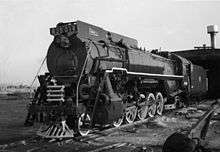CRRC Datong
CRRC Datong Co. Ltd. (Chinese: 中车大同电力机车有限责任公司; lit.: 'CRRC Datong Electric Locomotive Co.,Ltd.') is a Chinese railway locomotive manufacturing plant based in Datong, Shanxi, China, founded 1953. The factory was a major producer of steam locomotives for the Chinese market up to 1988 when production switched to diesel powered locomotives. By the 1990s electric locomotives had begun to be produced, and became the major product of the works.
 | |
Native name | 中车大同电力机车 有限责任公司 |
|---|---|
| wholly owned subsidiary | |
| Industry | Rail |
| Founded | 1953[1] |
| Headquarters | , China |
| Products | Locomotives |
| Parent | CRRC |
| Website | Official Website |
In 2003 the factory became CNR Datong Electric Locomotive Co. Ltd. (DELC) and a subsidiary of China CNR Corporation as part of a re-organisation of the Chinese railway manufacturing industry.
History

Datong Locomotive Factory was founded in 1954 as part of the first Chinese five-year plan for economic development.[1] The first locomotive was produced in 1959.[2][3]
By 1988 the factory had produced over 5000 steam locomotives, and was a major steam locomotive manufacturer in the People's Republic of China,[1] by the 1980s manufacturing between 250 and 300 locomotives yearly; many of these units were QJ "march forward" 2-10-2 heavy freight locomotives.[4] Steam locomotive production at Datong was a vertically integrated process, starting from raw steel.[5] The last steam locomotive to be produced at the plant, and in China,[n 1] was made on 21 December 1988.[7]
In the 1980s the plant began to manufacture diesel locomotives, including types DF4B and DF4C. By 1999 over 600 diesel locomotives had been produced.[1]
.jpg)
In 1990 the plant began to produce electric locomotives - the SS7 six axle Bo'Bo'Bo' and the SS7E Co'Co' mainline electrics were developed and manufactured at Datong.[1] The company was also jointly involved with Zhuzhou Electric Locomotive Works in the high-speed passenger EMU development project China Star in 2002.[1][8]
In 2003 the company became part of the China CNR Corporation, as CNR Datong Electric Locomotive Co. Ltd..[1]
In 2004 the company entered into a manufacturing and technology transfer agreement with Alstom,[9] leading to the production of the HXD2 series of locomotive classes. The first HXD2 locomotive to be manufactured in China was completed in 2007.[1][10] In August 2012, the first example of a localised version of the HXD2 locomotive was produced by the factory, numbered HXD2-1001.[11][12]
Joint ventures
The company has entered into joint ventures with ABC Rail Products (1996, castings), Stennmann (2002, Pantographs), Alstom (2004, locomotive manufacture), ABB Group (2007, electric transformers), SEMCO (India) (2007, Wheelsets) and Faiveley (2007, railway couplers).[1]
Museum
The factory site also included a museum,[13] in 2004 the collection was moved to Beijing.[14]
Notes
- It is reported that steam locomotive production for industrial railways continued up to 1999.[6]
References
- Sources:
中国北车集团大同电力机车有限责任公司 [CNR Datong Electric Locomotive Co. Ltd.]. www.dt.chinacnr.com (in Chinese). Archived from the original on 8 July 2011. Retrieved 6 February 2011.
中国北车集团大同电力机车有限责任公司 [CNR Datong Electric Locomotive Co. Ltd.]. www.dtloco.com (in Chinese). Archived from the original on 24 July 2011. Retrieved 6 February 2011.
"DATONG ELECTRIC LOCOMOTIVE CO.,LTD OF CNR : History". www.dt.chinacnr.com. Archived from the original on 19 January 2013. Retrieved 6 February 2011.
"DATONG ELECTRIC LOCOMOTIVE CO.,LTD OF CNR : Company Profile". dtloco.com. Archived from the original on 21 January 2013. Retrieved 6 February 2011. - Paul Theroux (2006) [1998], "2. The Inner Mongolian Express to Datong: Train Number 24", Riding the Iron Rooster: By Train Through China, Mariner Books - Houghton Mifflin, ISBN 0-618-65897-1
- Xia, Lin (1991), "Datong Locomotive Works Steams Ahead", Beijing Review, 34-35: 84
- Ian McNeil (2002). An Encyclopedia of the History of Technology. Routledge. "Surviving Steam" p.605. ISBN 9780415013062.
- William D. Middleton (2000). "Yet there isn't a train I wouldn't take": Railway journeys by William D. Middleton. Indiana University Press. pp. 172–3. ISBN 0253336996.
- Duncan Cotterill. "Railography : A Brief History of Standard Gauge Steam in China". www.railography.co.uk.
- Colin Mackerras; Amanda Yorke (1991). The Cambridge handbook of contemporary China. Cambridge University Press. pp. 50. ISBN 9780521387552.
datong locomotive.
- "中华之星" 交流传动电动车组. www.dtloco.com (in Chinese). Archived from the original on 2011-07-24. Retrieved 2011-02-06.
- Murray Hughes (1 March 2006). "Tide of technology pours into China". www.railwaygazette.com. Railway Gazette International. European electrics.
- 杨雄京 (Jing Yang Xiong) (31 May 2007). "9,600 kW electric locomotive rolled out". Archived from the original on 4 October 2011. Retrieved 6 February 2011.
- "中国北车创造世界铁路"重载之王"", www.chinacnr.com, 27 August 2012, archived from the original on 4 March 2016, retrieved 2 October 2012
- "CNR Datong unveils 10 MW locomotive designed to cross China", www.railwaygazette.com, 6 September 2012
- David Leffman; Simon Lewis; Jeremy Atiyah (2003). Rough guide to China. Rough Guides. The Yellow River : Datong and around : The Locomotive Factory, pp.236-7. ISBN 9781843530190.
- Damian Harper; Steve Fallon; Katja Gaskell (2005). China. Lonely Planet. Datong Locomotive Factory, pp.402. ISBN 9781740596879.
datong locomotive.
External links
| Wikimedia Commons has media related to Datong locomotive factory. |
- 永远的"四二八". b.qzone.qq.com (in Chinese). Social history of Datong locomotive factory (perspective)